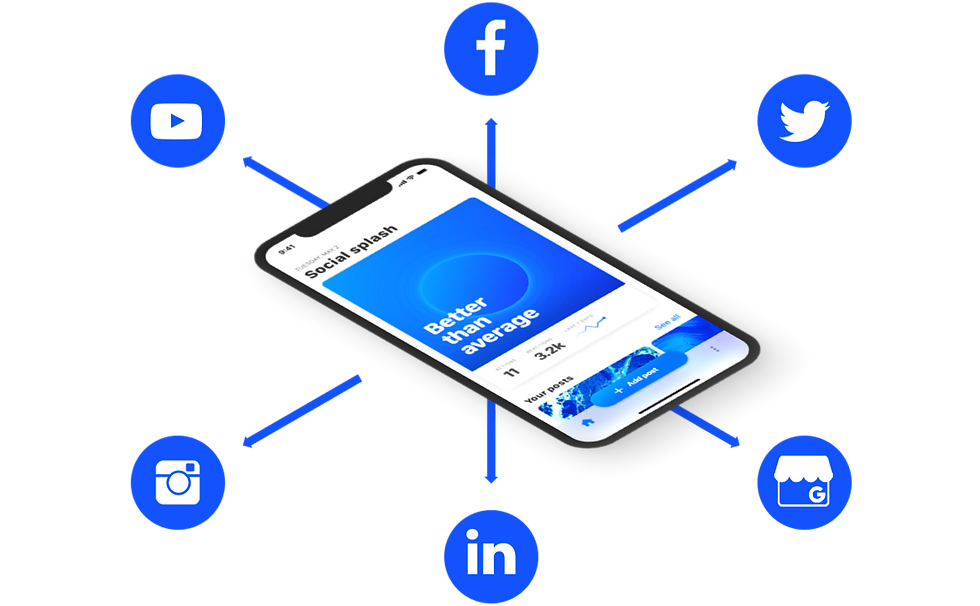How to promote your small business on social media - 5 easy steps to get you started
- Hookle

- Oct 29, 2019
- 6 min read
Updated: Jan 16, 2022

Shortcuts
Over the years, social media marketing has gone from a fresh new idea to an absolute must for any business. Yes, that includes small businesses, too.
After all, social media is the best way to connect with both loyal fans and potential new customers. Without it, you’re missing out on reaching an audience that’s willing to connect with your brand.
However, getting started on social media can be daunting for small business owners, especially if you don’t have any experience using it. Where to start? Which social media platforms to use? Does it take a lot of my time?
The good news is that you don’t need to have a slick marketing campaign or thousands of followers for social media to have a positive impact on your business. Social media doesn’t need to be scary, nor expensive!
To help get you started, here are five easy steps for you to kick-start a social media marketing strategy for your small business. You’re welcome.
1. Establish your online presence
Perhaps you haven’t yet created any social profiles for your small business. Or maybe you’re set up on just one. Let’s say Facebook, for example.
If you’re set up on one social media platform – great. You’re heading in the right direction. But using one social media platform alone isn’t enough to maximize your reach and draw in those customers.
Even small business owners need to establish a strong presence on social platforms to reach as much of their audience as possible.

These social media platforms include Facebook, Instagram, Twitter, YouTube, LinkedIn, and Snapchat to name a few. But before you rush off to create a profile on every platform listed, you must understand your target audience. This will help you decide which platforms to focus on.
With a wide and varied audience, focusing on Facebook to start with is a safe bet as you can assume your target audience has a presence there. Facebook is still one of the fastest-growing social media platforms, so rest assured that it’s not going anywhere for the time being. After setting your business's Facebook Page, you can now start evaluating what other platforms are relevant for your customers.
Do you run a B2B company? Then LinkedIn is the social platform for you. That’s because 80% of leads generated by B2B companies come from LinkedIn.
Or is your primary audience Generation Z? If so, you might want to head to Snapchat or Instagram to find the right followers. This is because 71% of Generation Z uses Snapchat at least six times a day! But if you’re trying to create leads from baby boomers, for example, it wouldn’t make sense to prioritize Snapchat.
2. Create an editorial calendar
To help you stay focused on your social media marketing strategy, creating an editorial calendar helps a great deal. After all, scrambling to craft posts at the last minute can lead to irrelevant or low-quality content that your followers won’t appreciate.
Plus, a lack of organization can lead to all sorts of bloopers, such as repeated posts (oops!) or a forgotten presence on one or more of your social channels.
A social media calendar helps you avoid those mistakes and assists you in planning a strong, useful, and relevant content strategy. They can also help you reach goals for your social media strategy and track your progress toward them.
To craft a content calendar, use a regular calendar for each social media channel you use and plan your posts accordingly. There are plenty of templates available to download for free online, or you could simply create your own using Google spreadsheets.
For each post, you can include hashtags, links, images, and any other content you plan to include. That way your content is ready to post each day without any extra work.
When you feel more comfortable using social media, you may be interested in trying out a social media tool like Hookle. This enables you to easily schedule posts in months or weeks in advance.
Scheduling also allows you to dedicate one block of time per week to spend creating content so you can focus on the job at hand. This means you don’t need to plan daily which can often take you away from other important tasks.
3. Post content regularly
Once you have your social media profiles ready, you need to make sure those accounts are active and engaged. After all, if a potential customer stumbles upon one of your profiles and sees there’s been no activity for a month, they aren’t going to follow you.
Because why would someone follow a brand that doesn’t post regular or consistent content? Would you?
That’s why posting daily, or at least several times a week is recommended not only to draw in new followers but to keep current ones engaged and entertained. Think about it – the followers you do already have aren’t likely to search your brand just to see what you’re up to. They need a prompt – an exciting and informative piece of content that will appear on their timeline or homepage.

Posting daily can work well with your content calendar. By planning ahead of schedule, you can make sure there’s content ready for every day and can spot any missing gaps.
Have a look at how often your competitors are posting too. If they’re only posting weekly or a handful of times a month then this is a great opportunity to stand out. Likewise, if they’re posting quality content daily, then you know you need to keep up so you don’t get lost.
If you post daily, then every time your followers see your brand pop up they’re reminded that you exist. And when they get to a point where they need or want the product you’re offering they’ll think of you before any other competitor.
If you’re not sure exactly what to post, be creative and mix it up. Share blog articles, videos, and images that are relevant to your industry. Promote a special offer you’re currently running.
It doesn’t always have to be a big piece of content, sometimes just sharing a relevant article can pique the interests of followers.
One super-easy way to keep active is to set up a recurring posts system, which is a massive time saver. You can set certain static posts, such as events or happy hours, to be automatically repeated so that you don't need to think about scheduling or posting them separately for months or even the rest of the year.
4. Provide value
This leads us to the importance of sharing content that provides value to your target audience. After all, there’s no point in posting daily if it comes across as spam or holds no relevance to your followers.
Create content that your audience will find useful. It could be a guidance article or a video that makes them laugh, for example. Anything beneficial to them in some way.
This is what helps draw the right customers to your small business and will make them want to follow you on social media and spread the content you’ve shared. Share the right content and you can connect with your target audience and grow a loyal customer base.
One mistake that many small businesses make is treating social media too similarly to regular advertising. While self-promotion is necessary – it’s the aim of the game, after all – you shouldn’t blatantly promote your business in every post.
When you do promote your business, make sure you mix it up and do it sporadically. Many marketers go by the one-in-seven rule, suggesting that for every one obvious promotional post, there should be six others that are content-based.
You can still mention your brand and services in these other posts, just be careful not to sell too hard and don’t make your brand the focus of the post.
Visual content works especially well on social media. For example, video content is ideal for drawing the browser’s attention as well as conveying your personality to customers in a fun way.
5. Encourage engagement
Once you’ve started posting, the work isn’t done there. Social media should, of course, be social so you should interact with followers as much as you can.
Ask questions in your content, so people are more likely to engage and leave a comment. Then, reply to their comments and slowly build a rapport. Generally, people find it more encouraging and authentic when businesses reach out and respond to their customers via social media.
While you should always try to draw in new followers, it’s important to focus on the followers you do have that are interested, loyal, and engaged. These are the people who are more likely to repost your content and become customers.
Once you’ve built a community of loyal followers around your brand, these people will interact and engage with one another, working together to help promote your content and brand.
Ready to start marketing on social media?
Following these five easy steps, promoting your small business on social media doesn’t have to be difficult or overwhelming.
Remember that to stay relevant today, your small business must have an active social media presence. And that having one social profile alone isn’t enough if you want to maximize your reach to potential customers.
Hookle is a tool created to help you keep your business active and engaging on social media. With Hookle you can keep an eye on all of your business’s social media networks, publish post effortlessly and see the impact of your activity - all on one app. Download and try out Hookle now here.
With time, you’ll soon grow a following that you can engage with and hopefully convert into customers.
Ready to get started? Good luck!
















.png)
.png)



.png)